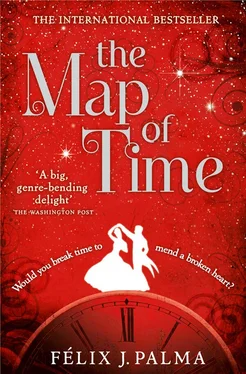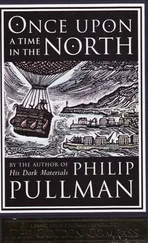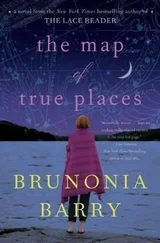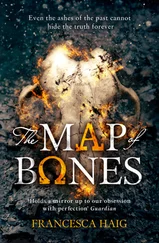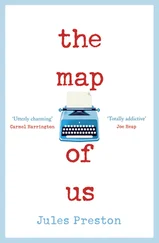Then Murray asked them to concentrate on the most intricate part of the map, the African continent. There, all of the expeditions that had attempted to discover the mythical source of the Nile -those of the Dutchwoman Alexandrine Tinné, Mr and Mrs Baker, Burton and Speke and, most famously, Livingstone and Stanley, as well as many more – converged to form a tangled mesh, which, if nothing else, illustrated the fascination Africa had held for the intrepid wearers of pith helmets.
‘The account of how we discovered time travel began exactly twenty-two years ago,’ Murray announced theatrically.
As he had heard the story many times before, Eternal stretched out at his master’s feet. Charles smiled gleefully at this promising beginning, while Andrew’s lips twisted in frustration. He realised he would need a lot of patience before he found out whether or not he would be able to save Marie Kelly.
Chapter VIII
Permit me, if you will, to perform a little narrative juggling at this point, and recount the story Gilliam Murray told them in the third person instead of the first, as if it were an excerpt from an adventure story, which is the way Murray would ultimately have liked to see it.
Back then, at the beginning of the nineteenth century, the main ambition of most expeditionary societies was to discover the source of the Nile, which Ptolemy had situated in the Mountains of the Moon, the magnificent range rising out of the heart of Africa. However, modern explorers seemed to have had no more luck than Herodotus, Nero or anyone else who had searched in vain for it throughout history. Richard Burton and John Speke’s expedition had only succeeded in making enemies of the two explorers, and David Livingstone’s had thrown little light on the matter.
When Henry Stanley found Livingstone in Ujiji, he was suffering from dysentery. Nevertheless, he refused to return with Stanley to the metropolis and set off on another expedition, this time to Lake Tanganyika. He had to be brought back from there on a litter, racked with fever and utterly exhausted. The Scottish explorer died at Chitambo, and his final journey was made as a corpse, embalmed and enclosed in a large piece of bark from a myonga tree. It took porters nine months to carry him to the island of Zanzibar, whence he was finally repatriated to Great Britain. He was buried in 1878 in Westminster Abbey with full honours, the source of the Nile remaining a mystery.
Everyone, from the Royal Geographic Society to the most insignificant science museum, wanted to take credit for discovering its elusive location. The Murray family were no exception, and at the same time as the New York Herald and the London Daily Telegraph sponsored Stanley’s new expedition, they, too, sent one of their most experienced explorers to the inhospitable African continent.
His name was Oliver Tremanquai, and he had undertaken several expeditions to the Himalayas. He was also a veteran hunter. Among the creatures he killed with his expert marksmanship were Indian tigers, Balkan bears and Ceylonese elephants. Although never a missionary, he was a deeply religious man, and never missed an opportunity to evangelise any natives he might come across, listing the merits of his God like someone selling a gun.
Excited about his new mission, Tremanquai left for Zanzibar, where he acquired porters and supplies. However, a few days after he had made his way into the continent the Murrays lost all contact with him. The weeks crept by and still they received no message. They began to wonder what had become of the explorer. With great sorrow, they gave him up for lost as they had no Stanley to send after him.
Ten months later, Tremanquai burst into their offices, days after a memorial service had taken place with the permission of his wife – loath to don her widow’s weeds. As was only to be expected, his appearance caused the same stir as if he had been a ghost. He was terribly gaunt, his eyes were feverish, and his filthy, malodorous body hardly looked as if he had spent the intervening months washing in rosewater. As was obvious from his deplorable condition, the expedition had been a complete disaster from the outset. No sooner had they penetrated the jungle than they were ambushed by Somali tribesmen. Tremanquai was unable even to take aim at those feline shadows emerging from the undergrowth before he was felled by a cascade of arrows. There, in the stillness of the jungle, far from the eyes of civilisation, the expedition was brutally massacred. The attackers had left him for dead, like his men.
But life had toughened Tremanquai and he had survived. He roamed the jungle for weeks, wounded and feverish, arrows still stuck in his flesh, using his rifle as a crutch, until his pitiful wanderings brought him to a small native village encircled by a palisade. Exhausted, he collapsed before the narrow entrance to the fence, like a piece of flotsam washed up by the sea.
He awoke several days later completely naked, stretched out on an uncomfortable straw mattress with repulsive poultices on his wounds. He was unable to identify the features of the young girl applying the sticky greenish dressings as belonging to any of the tribes he knew. Her body was long and supple, her hips extremely narrow and her chest almost as flat as a board. Her dark skin gave off a faint, dusky glow. He soon discovered that the men possessed the same slender build, their delicate bone structure almost visible beneath their slight musculature. Not knowing what tribe they belonged to, Tremanquai decided to invent a name for them. He called them the Reed People, because they were as slim and supple as reeds.
Tremanquai was an excellent shot, but he had little imagination. The Reed People’s otherworldly physique, as well as the big black eyes in their exquisite doll-like faces, was a source of astonishment, but as his convalescence progressed, he discovered further reasons to be amazed: the impossible language they used to communicate with each other, a series of guttural noises he found impossible to reproduce, even though he was accustomed to imitating the most outlandish dialects; the fact that they all looked the same age; and the absence in the village of the most essential everyday implements. It was as though the life of these savages took place elsewhere, or as if they had succeeded in reducing it to a single act: breathing.
But one question above all preyed insistently on Tremanquai’s mind: how did the Reed People resist the neighbouring tribes’ repeated attacks? They were few in number, they looked neither strong nor fierce, and apparently his rifle was the only weapon in the village.
He soon discovered the answer. One night, a lookout warned that ferocious Masai tribesmen had surrounded the village. From his hut, with his carer, Tremanquai watched his saviours form a group in the centre of the village facing the narrow entrance, which curiously had no door. Standing in a fragile line as though offering themselves up for sacrifice, the Reed People linked hands and began to chant an intricate tune. Recovering from his astonishment, Tremanquai reached for his rifle and dragged himself back to the window with the intention of defending his hosts as best he could. Scarcely any torches were lit in the village, but the moon cast sufficient light for an experienced hunter like himself to take aim. He set his sights on the gap in the stockade, hoping that if he managed to pick off a few Masai the others might think the village was defended by white men and flee.
To his surprise, the girl gently lowered his weapon, indicating to him that his intervention was unnecessary. Tremanquai bridled, but the Reed girl’s serene gaze made him think again. From his window, he watched with trepidation and bewilderment as the savage horde of Masai spilled through the entrance and his hosts carried on their discordant incantation while the spears came ever closer. The explorer steeled himself to witness the passive slaughter.
Читать дальше
